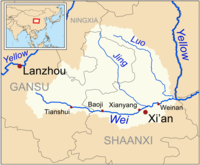
Photo from wikipedia
The Xi’an geothermal field is a typical medium–low-temperature group of geothermal reservoirs in the Guanzhong Basin. Three distinct groundwater systems occur in this field: the cold groundwater (CG) system (quaternary… Click to show full abstract
The Xi’an geothermal field is a typical medium–low-temperature group of geothermal reservoirs in the Guanzhong Basin. Three distinct groundwater systems occur in this field: the cold groundwater (CG) system (quaternary cold-water reservoir with a depth of less than 300 m); the shallow geothermal water (SGW) system (the Quaternary, Zhangjiapo Group, and Lantian-Bahe Group thermal reservoirs with depths ranging between 300 and 2000 m); the deep geothermal water (DGW) system (the Gaoling Group, Bailuyuan Group, and Proterozoic crystalline rock fissure thermal reservoirs, with depths of more than 2000 m). The chemical composition of the CG system consists of HCO3–Ca and HCO3–Ca–Mg water types with a low Total Dissolved Solids’ (TDS) content. The chemical composition of the SGW system consists of SO4–Na and SO4–HCO3–Na water types that have resulted from the partial mixing with water from the CG system through fault structures. Calculations suggest that about 39.4–42.7% of the water in the SGW system was derived from the CG system. The chemical composition of the DGW system consists of SO4–Na and SO4–Cl–Na water types with elevated TDS, F−, SiO2, and high ion concentrations due to the long residence time of water in this largely closed system. The use of geothermometers, multiple mineral equilibrium calculations, and the silica-enthalpy mixing model suggests that temperatures in the SGW and DGW systems lie in the range of 40–85 °C and 94.7–135 °C, respectively. The chalcedony geothermometer is considered to provide the most reliable temperature estimates of the shallow reservoir, whereas the quartzb (maximum steam loss 100 °C) and Na–K geothermometers are considered to provide the most reliable estimates for the deep thermal reservoir. The results of a Q-cluster classification of the water agree well with the field classification of the sampled waters, and the associations of the principal variables obtained by the R-cluster method are consistent with the results obtained by the conventional hydrogeochemical assessment of the samples.
Journal Title: Environmental Earth Sciences
Year Published: 2019
Link to full text (if available)
Share on Social Media: Sign Up to like & get
recommendations!